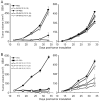Fractionated but not single-dose radiotherapy induces an immune-mediated abscopal effect when combined with anti-CTLA-4 antibody
- PMID: 19706802
- PMCID: PMC2746048
- DOI: 10.1158/1078-0432.CCR-09-0265
Fractionated but not single-dose radiotherapy induces an immune-mediated abscopal effect when combined with anti-CTLA-4 antibody
Abstract
Purpose: This study tested the hypothesis that the type of dose fractionation regimen determines the ability of radiotherapy to synergize with anti-CTLA-4 antibody.
Experimental design: TSA mouse breast carcinoma cells were injected s.c. into syngeneic mice at two separate sites, defined as a "primary" site that was irradiated and a "secondary" site outside the radiotherapy field. When both tumors were palpable, mice were randomly assigned to eight groups receiving no radiotherapy or three distinct regimens of radiotherapy (20 Gy x 1, 8 Gy x 3, or 6 Gy x 5 fractions in consecutive days) in combination or not with 9H10 monoclonal antibody against CTLA-4. Mice were followed for tumor growth/regression. Similar experiments were conducted in the MCA38 mouse colon carcinoma model.
Results: In either of the two models tested, treatment with 9H10 alone had no detectable effect. Each of the radiotherapy regimens caused comparable growth delay of the primary tumors but had no effect on the secondary tumors outside the radiation field. Conversely, the combination of 9H10 and either fractionated radiotherapy regimens achieved enhanced tumor response at the primary site (P < 0.0001). Moreover, an abscopal effect, defined as a significant growth inhibition of the tumor outside the field, occurred only in mice treated with the combination of 9H10 and fractionated radiotherapy (P < 0.01). The frequency of CD8+ T cells showing tumor-specific IFN-gamma production was proportional to the inhibition of the secondary tumor.
Conclusions: Fractionated but not single-dose radiotherapy induces an abscopal effect when in combination with anti-CTLA-4 antibody in two preclinical carcinoma models.
Figures







References
-
- Apetoh L, Ghiringhelli F, Tesniere A, et al. Toll-like receptor 4-dependent contribution of the immune system to anticancer chemotherapy and radiotherapy. Nat Med. 2007;13:1050–9. - PubMed
-
- Lugade AA, Moran JP, Gerber SA, Rose RC, Frelinger JG, Lord EM. Local radiation therapy of B16 melanoma tumors increases the generation of tumor antigen-specific effector cells that traffic to the tumor. J Immunol. 2005;174:7516–23. - PubMed
-
- Demaria S, Formenti SC. Sensors of ionizing radiation effects on the immunological microenvironment of cancer. Int J Radiat Biol. 2007;83:819–25. - PubMed
Publication types
MeSH terms
Substances
Grants and funding
LinkOut - more resources
Full Text Sources
Other Literature Sources
Medical
Research Materials

